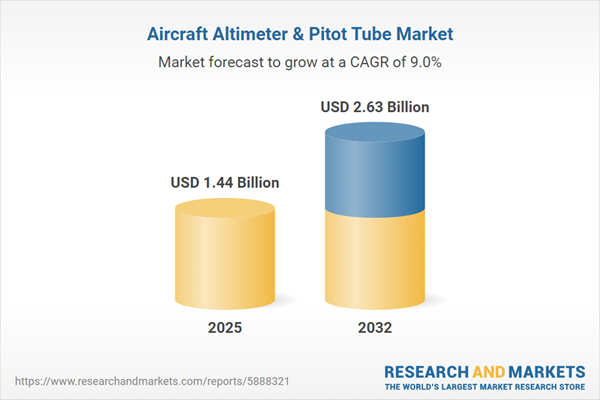Speak directly to the analyst to clarify any post sales queries you may have.
Senior executives in aviation are navigating a period of dynamic transformation, where technological innovation, regulatory complexity, and the imperative of operational efficiency converge. The aircraft altimeter and pitot tube market plays a central role, demanding strategic foresight and accurate data to drive effective procurement and mitigate evolving industry risks.
Market Snapshot: Aircraft Altimeter & Pitot Tube Market
The global aircraft altimeter and pitot tube market reached USD 1.32 billion in 2024, signaling sustained momentum in a critical sector underpinning aviation safety and performance. Projections indicate a rise to USD 1.44 billion in 2025, with a healthy compound annual growth rate of 8.97%. By 2032, market value is anticipated to surpass USD 2.63 billion, propelled by ongoing investment in sensor reliability and relevance for commercial and defense aviation stakeholders. The landscape is shaped by next-generation measurement technologies, innovation in cockpit instrumentation, and procurement alignment with regulatory and operational benchmarks.
Scope & Segmentation: Strategic Structure for Senior Decision-Makers
This analysis equips procurement and operations leaders with actionable insight across emerging opportunities in the aircraft altimeter and pitot tube systems space worldwide. Segmentation thoroughly addresses procurement priorities and operational planning:
- Product Type: Barometric, radar, and radio altimeters, each available in both analog and digital versions. Heated and unheated pitot tubes constructed from resilient metals such as aluminum and stainless steel ensure reliability across varied operating environments.
- End User: Applications range across commercial, general, and military aviation sectors. Each segment reflects distinct adoption timelines, upgrade cycles, and specific mission-driven requirements.
- Installation Type: Solutions span both aftermarket retrofits and original equipment manufacturer (OEM) deployments. This flexibility supports incremental fleet updates, complete system renewals, and phased technology upgrades.
- Sales Channel: Direct sales, diverse distribution networks, and e-commerce platforms provide procurement teams with customizable sourcing and supplier engagement pathways.
- Technology: Advancement in analog and digital sensor designs strengthens compatibility with predictive analytics, maintenance automation, and real-time monitoring tools.
- Aircraft Type: Suits fixed wing and rotary wing platforms, optimizing functionality for passenger, cargo, regional, and niche operational needs within global commercial and defense fleets.
- Price Range: Encompasses high-end, mid-level, and entry-level solutions, ensuring that operators with varying budgetary constraints or investment strategies find suitable options across fleet scales.
- Geographic Scope: Spans North and South America, Europe, Middle East and Africa, and Asia-Pacific, incorporating analysis of regional regulation, fleet renewal programs, and infrastructure advancements that influence adoption rates.
- Key Companies: Features leaders including Honeywell International Inc., RTX Corporation, Safran S.A., Thales S.A., Parker Hannifin Corporation, Eaton Corporation plc, AMETEK Inc., Sensata Technologies Holdings plc, Teledyne Technologies Incorporated, and Garmin Ltd., collectively reflecting international capacity and sustained innovation in flight sensor technology.
Key Takeaways: Insights for Sensor Technology Stakeholders
- Digital sensor platforms offer improved analytics, enabling proactive maintenance planning and boosting asset reliability for diverse fleet operations.
- The use of advanced lightweight materials in sensor construction increases fuel efficiency while reducing equipment lifecycle costs, specifically benefiting operators focusing on cost-per-flight-hour reduction.
- Enhanced compliance protocols and new cybersecurity measures now form core criteria for procurement, assuring both supply chain stability and reduced risk.
- Regional market behavior differs: Asia-Pacific leads in new avionics adoption, whereas Europe and North America emphasize fleet retrofitting to align with updated safety and technology standards.
- Modular system designs simplify installation and facilitate expansion, minimizing downtime and supporting scalable fleet upgrades in both scheduled and emergency settings.
Tariff Impact: Navigating US Policy and Cost Adjustments in 2025
Recent policy shifts have driven up input costs for electronics and raw materials in the United States, increasing production and supply chain challenges for sensor technology. Suppliers are mitigating these risks by expanding sourcing options and adjusting manufacturing locations to manage cost volatility and support sustainable, timely delivery. For procurement leaders, leveraging adaptable sourcing approaches and fostering reliable supplier partnerships remains essential to safeguard continuity in a fluid regulatory climate.
Methodology & Data Sources
Market insights derive from direct engagement with aviation professionals, triangulated with in-depth secondary research and quantitative modeling. Scenario evaluation and expert qualitative review ensure rigorous, sector-relevant analysis throughout the value chain.
Why This Report Matters: Strategic Value for Senior Leaders
- Comprehensive segmentation and robust regional analysis enable informed budget allocation, technology investment, and responsive compliance integration.
- Clear, actionable recommendations help decision-makers anticipate regulatory developments and seamlessly adopt analytics-driven solutions, strengthening risk management capacity.
Conclusion
This report equips senior aviation leaders with the insight needed to prioritize sensor technology, build operational resilience, and proactively address evolving risks in a rapidly shifting industry environment.
Additional Product Information:
- Purchase of this report includes 1 year online access with quarterly updates.
- This report can be updated on request. Please contact our Customer Experience team using the Ask a Question widget on our website.
Table of Contents
3. Executive Summary
4. Market Overview
7. Cumulative Impact of Artificial Intelligence 2025
Companies Mentioned
The companies profiled in this Aircraft Altimeter & Pitot Tube market report include:- Honeywell International Inc.
- RTX Corporation
- Safran S.A.
- Thales S.A.
- Parker Hannifin Corporation
- Eaton Corporation plc
- AMETEK, Inc.
- Sensata Technologies Holdings plc
- Teledyne Technologies Incorporated
- Garmin Ltd.
Table Information
| Report Attribute | Details |
|---|---|
| No. of Pages | 196 |
| Published | October 2025 |
| Forecast Period | 2025 - 2032 |
| Estimated Market Value ( USD | $ 1.44 Billion |
| Forecasted Market Value ( USD | $ 2.63 Billion |
| Compound Annual Growth Rate | 8.9% |
| Regions Covered | Global |
| No. of Companies Mentioned | 11 |









